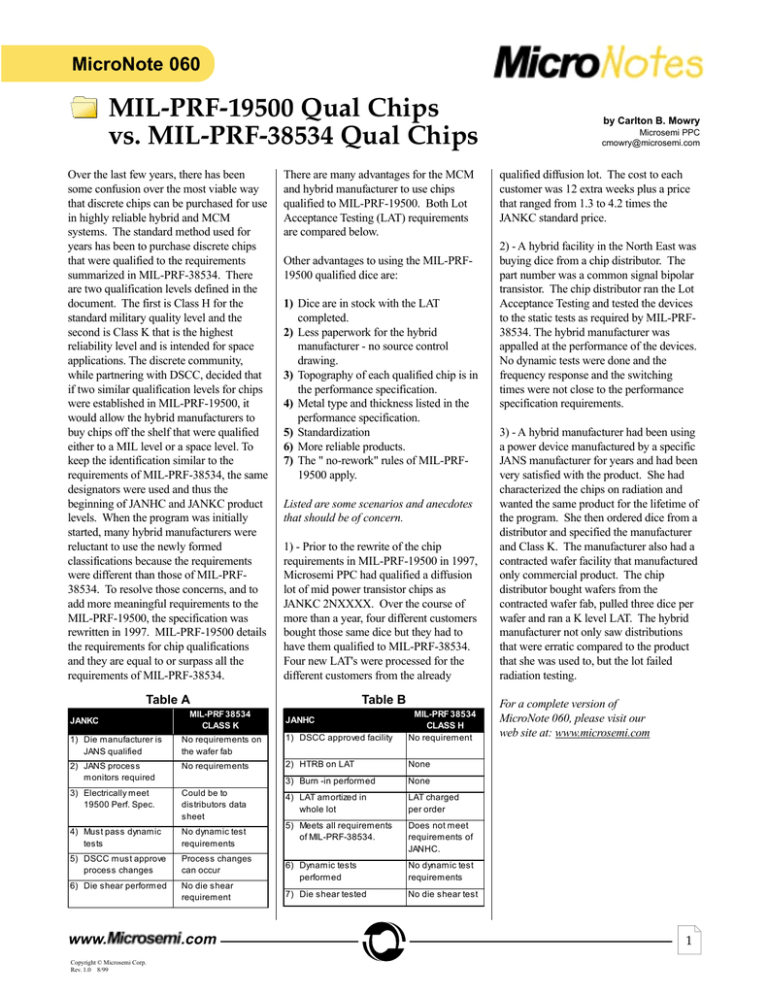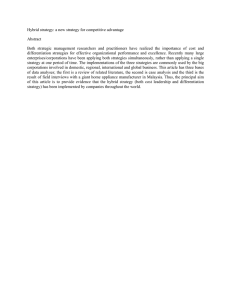MIL-PRF-19500 Qual Chips vs. MIL-PRF-38534 Qual
advertisement

MicroNote 060 MIL-PRF-19500 Qual Chips vs. MIL-PRF-38534 Qual Chips Over the last few years, there has been some confusion over the most viable way that discrete chips can be purchased for use in highly reliable hybrid and MCM systems. The standard method used for years has been to purchase discrete chips that were qualified to the requirements summarized in MIL-PRF-38534. There are two qualification levels defined in the document. The first is Class H for the standard military quality level and the second is Class K that is the highest reliability level and is intended for space applications. The discrete community, while partnering with DSCC, decided that if two similar qualification levels for chips were established in MIL-PRF-19500, it would allow the hybrid manufacturers to buy chips off the shelf that were qualified either to a MIL level or a space level. To keep the identification similar to the requirements of MIL-PRF-38534, the same designators were used and thus the beginning of JANHC and JANKC product levels. When the program was initially started, many hybrid manufacturers were reluctant to use the newly formed classifications because the requirements were different than those of MIL-PRF38534. To resolve those concerns, and to add more meaningful requirements to the MIL-PRF-19500, the specification was rewritten in 1997. MIL-PRF-19500 details the requirements for chip qualifications and they are equal to or surpass all the requirements of MIL-PRF-38534. There are many advantages for the MCM and hybrid manufacturer to use chips qualified to MIL-PRF-19500. Both Lot Acceptance Testing (LAT) requirements are compared below. Other advantages to using the MIL-PRF19500 qualified dice are: 1) Dice are in stock with the LAT completed. 2) Less paperwork for the hybrid manufacturer - no source control drawing. 3) Topography of each qualified chip is in the performance specification. 4) Metal type and thickness listed in the performance specification. 5) Standardization 6) More reliable products. 7) The " no-rework" rules of MIL-PRF19500 apply. Listed are some scenarios and anecdotes that should be of concern. 1) - Prior to the rewrite of the chip requirements in MIL-PRF-19500 in 1997, Microsemi PPC had qualified a diffusion lot of mid power transistor chips as JANKC 2NXXXX. Over the course of more than a year, four different customers bought those same dice but they had to have them qualified to MIL-PRF-38534. Four new LAT's were processed for the different customers from the already Table A Table B 1) Die manufacturer is JANS qualified No requirements on the wafer fab 1) DSCC approved facility MIL-PRF 38534 CLASS H No requirement 2) JANS process monitors required No requirements 2) HTRB on LAT None 3) Burn -in performed None 3) Electrically meet 19500 Perf. Spec. Could be to distributors data sheet 4) LAT amortized in whole lot LAT charged per order 4) Must pass dynamic tests No dynamic test requirements 5) Meets all requirements of MIL-PRF-38534. Does not meet requirements of JANHC. 5) DSCC must approve process changes Process changes can occur 6) Dynamic tests performed No dynamic test requirements 6) Die shear performed No die shear requirement 7) Die shear tested No die shear test JANKC www. Copyright © Microsemi Corp. Rev. 1.0 8/99 MIL-PRF 38534 CLASS K .com JANHC by Carlton B. Mowry Microsemi PPC cmowry@microsemi.com qualified diffusion lot. The cost to each customer was 12 extra weeks plus a price that ranged from 1.3 to 4.2 times the JANKC standard price. 2) - A hybrid facility in the North East was buying dice from a chip distributor. The part number was a common signal bipolar transistor. The chip distributor ran the Lot Acceptance Testing and tested the devices to the static tests as required by MIL-PRF38534. The hybrid manufacturer was appalled at the performance of the devices. No dynamic tests were done and the frequency response and the switching times were not close to the performance specification requirements. 3) - A hybrid manufacturer had been using a power device manufactured by a specific JANS manufacturer for years and had been very satisfied with the product. She had characterized the chips on radiation and wanted the same product for the lifetime of the program. She then ordered dice from a distributor and specified the manufacturer and Class K. The manufacturer also had a contracted wafer facility that manufactured only commercial product. The chip distributor bought wafers from the contracted wafer fab, pulled three dice per wafer and ran a K level LAT. The hybrid manufacturer not only saw distributions that were erratic compared to the product that she was used to, but the lot failed radiation testing. For a complete version of MicroNote 060, please visit our web site at: www.microsemi.com 1
